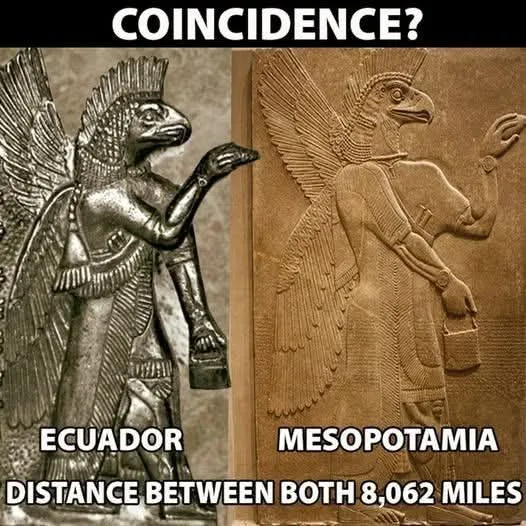Coincidence or Hidden Connection? The Mysterious Winged Beings of Ecuador and Mesopotamia
In the vast landscape of ancient mysteries, few images spark as much curiosity as this one: two humanoid figures with wings, bird-like faces, and strikingly similar postures—one said to be from Ecuador, the other from ancient Mesopotamia. With over 8,000 miles between them and thousands of years of cultural isolation, how is such a resemblance possible?

Is it mere coincidence… or evidence of something far more profound?
The Figures in Question
On the right, we see a well-documented figure from ancient Mesopotamia, often associated with the Anunnaki or Apkallu—mythical beings said to possess immense knowledge and divine origin. These figures are usually depicted with wings, animalistic features, and objects like pine cones or buckets, believed to symbolize purification or divine power.
On the left, labeled as being from Ecuador, is a very similar carving: a humanoid with wings and the head of a bird, standing in nearly the same pose. According to some, this artifact was found among the mysterious La Mana artifacts in Ecuador—items that have long been the subject of fringe archaeology and alternative history theories.

A Global Mystery
What truly captures the imagination is not just the visual resemblance, but the distance between the two locations—over 8,000 miles apart. With no known trade routes or connections between ancient Sumer and the indigenous peoples of the Andes, how could such similar imagery exist?
This question has fueled theories ranging from:
- Ancient global civilization theories (such as Atlantis or Mu)
- Ancient astronaut hypotheses (suggesting extraterrestrial influence)
- Lost technologies or forgotten migrations that connected early cultures
The symbols of bird-headed deities or gods descending from the sky appear in many ancient traditions. Could they all be independently imagining similar beings—or is there a common thread we’re missing?
Skepticism and Academic Viewpoints
Mainstream archaeologists argue that these similarities are coincidental or exaggerated. They suggest that many of the so-called “Ecuadorian” artifacts are either:
- Modern fabrications
- Incorrectly identified
- Or simply misunderstood ceremonial items from later indigenous cultures
While the Mesopotamian figure is verifiable, the origins of the Ecuadorian sculpture remain highly controversial, with no clear documentation or peer-reviewed research backing its authenticity.
Why This Still Matters
Whether hoax or history, this image continues to spark questions about humanity’s past. Are there lost pages of our story buried beneath jungle soils or forgotten in ancient ruins? Could ancient cultures have known more than we give them credit for?
More importantly, the comparison invites us to look deeper into our collective heritage—to question, to wonder, and to explore.
Because sometimes, even if it is just a coincidence, it still might point us toward greater truths.
Final Thoughts
Whether you’re a skeptic or a seeker of hidden knowledge, one thing’s for sure: images like this challenge our understanding of history. And that, in itself, is worth exploring.
What do you think? Coincidence—or connection?
Drop your thoughts in the comments and let the mystery unravel.


